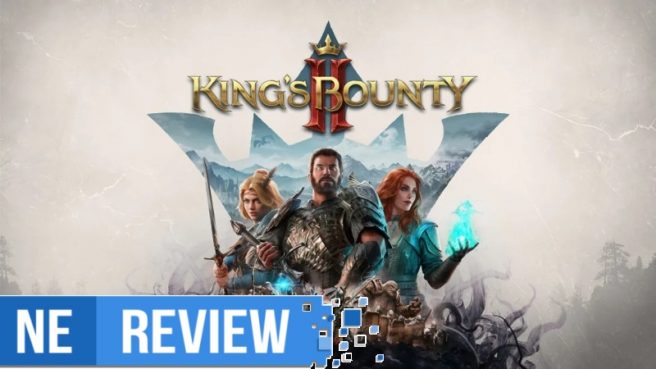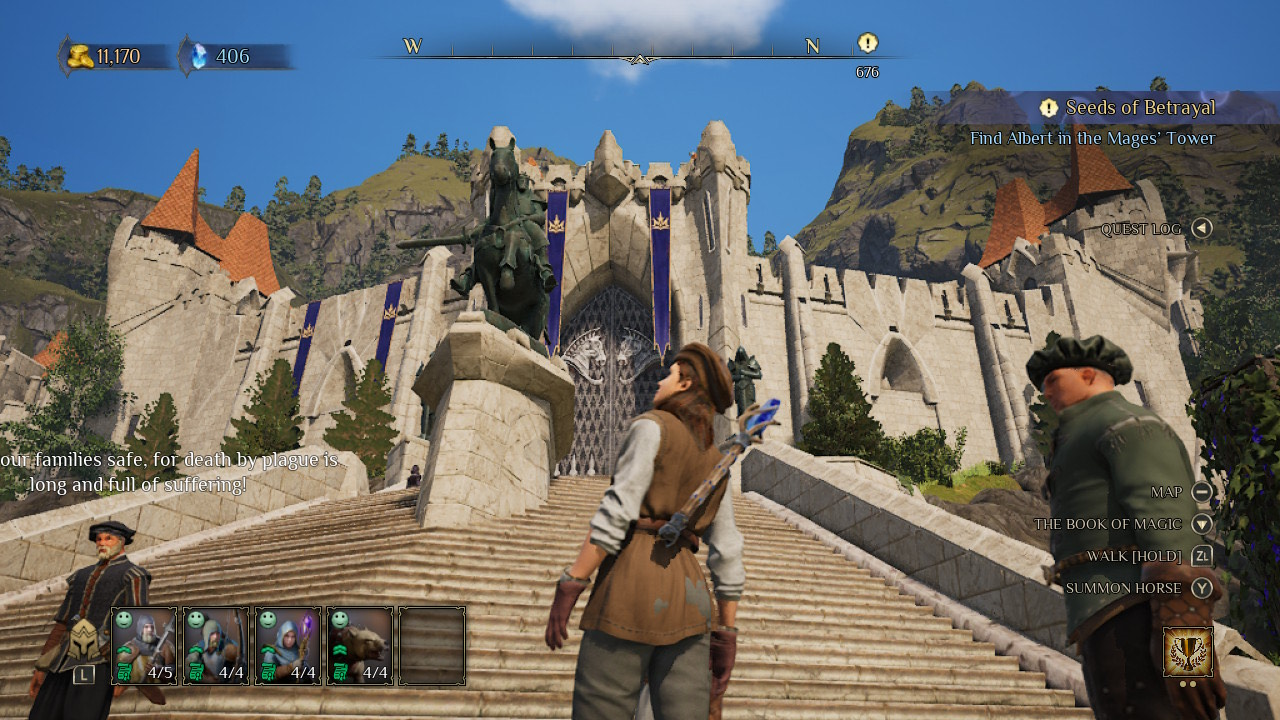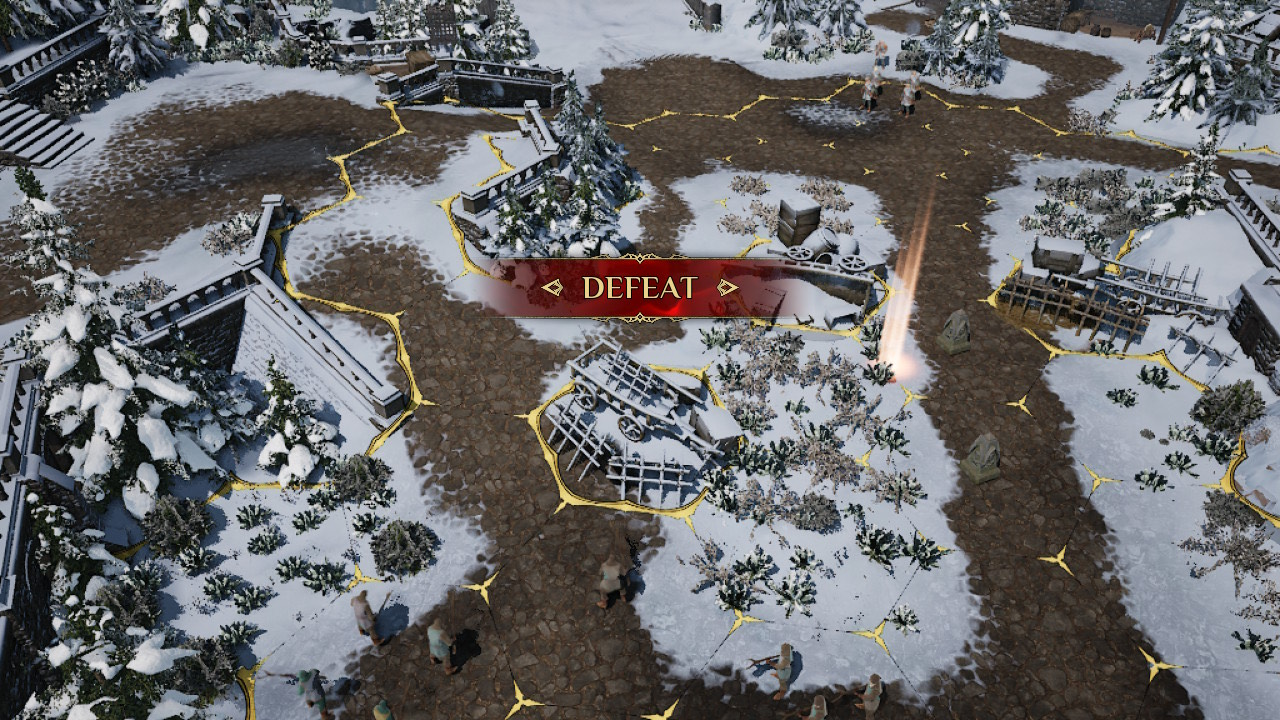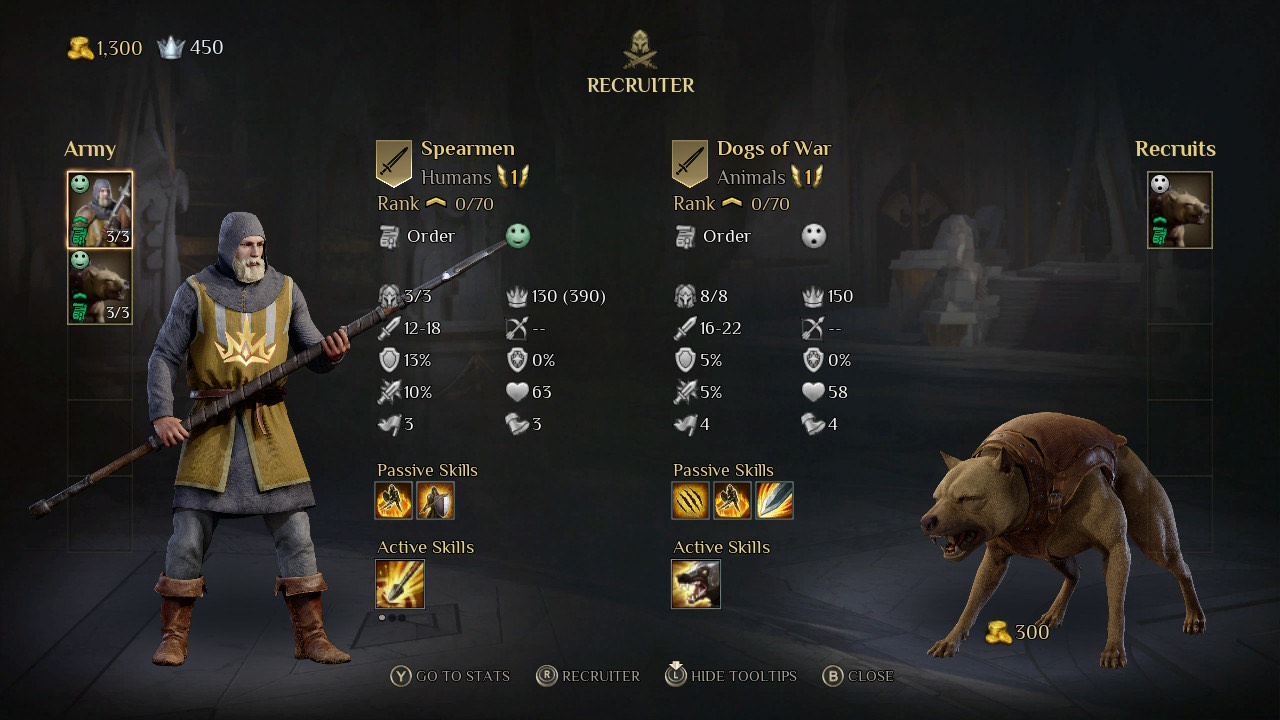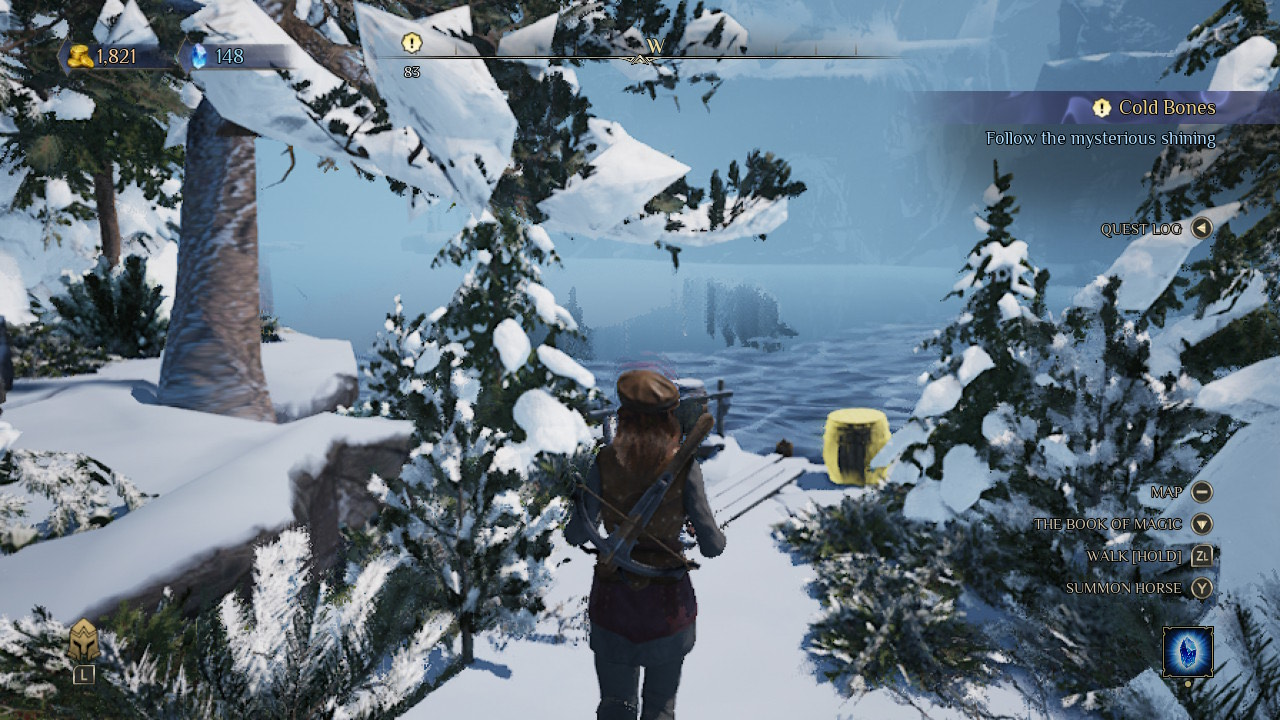System: Switch
Release date: August 24, 2021
Developer: 1C Entertainment
Publisher: 1C Entertainment / Prime Matter
Over the past few years, the turn-based strategy genre has become awash with new entries in some of its most landmark franchises; in retrospect, it should have seemed inevitable that someday, eventually, King’s Bounty would return on modern hardware. But I doubt that even longtime fans of this dormant franchise had expected to witness such an ambitious reinvention of the series’ name. Sure, at its heart, King’s Bounty II is still a grid-centric, turn-based strategy game with a traditional medieval setting, but with this new release, 1C Entertainment and Prime Matter have attempted to integrate more immersive role-playing elements, a grander world, and a completely different pace than the last game in the series. And while some of these new ideas can be well-executed individually, I left King’s Bounty II feeling unimpressed by the package as a whole.
First, it’s important to mention from the outset that this game is a mess on the Switch from both visual and performance perspectives, particularly in docked mode. While I can generally forgive a few technical shortcomings here and there, the Switch version of Kings Bounty II is utterly ruined by poor optimization. The game can look good in screenshots, but in motion it is a choppy, blurry mess on the TV (handheld mode is low-rez, but much more playable on a smaller screen). The frame rate will regularly drop into the low twenties on the big screen – and sometimes even lower – particularly in areas lush with foliage or buildings (so, basically the whole map). Just as problematic is the fact that the moment you adjust the game’s camera, or move your character forward, any sharpness or detail in any of the objects or environments on-screen is immediately lost, as the game seemingly lowers the resolution of everything on screen to the “Vaseline” preset to keep running. Combined, these two problems, I kid you not, actually made me feel nauseous when playing on the TV, which is a very rare occurrence for me. It’s simply an unpleasant experience on the Switch when doing absolutely anything other than standing still.
The game runs most consistently during its top-down, turn-based battles, as well as during conversation scenes between the protagonist and certain NPCs. But there are other issues here, unfortunately. In battles, the lack of anti-aliasing within the game combined with the distant camera perspective can occasionally make it needlessly challenging to locate units on the battlefield as they can somewhat blend in with the equally low-resolution shrubbery. The conversation scenes, meanwhile – which bring the camera in up close and personal with whoever is talking – are problematic in that its here that character models counterintuitively seem to be at their ugliest. I’m talking lifeless facial features, muddy textures and most distractingly, weird colored splotches all over my protagonist’s hair.
It’s a shame, too, because the world that 1C Entertainment has created feels vibrant, lived-in, and filled with little details that help make it feel like a real place. Crops sway in the breeze as you ride by on horseback. A young couple has a romantic, slightly awkward conversation at a tucked-away tower overlooking a grand vista, which you overhear as you pass through. Even the vendor stands feel intricately crafted – some of them are littered with stray fruits strewn about or clumsy piles of armor, almost making it feel as if the merchants had been in a hurry to set up that morning. Once I had exited the game’s opening area and the story really began to ramp up, I felt like I was exploring a slice of medieval history that could have maybe existed in some strange alternate timeline. There are moments when the game can be quite pretty – I just wish it was easier to see it all!
For my playthrough of King’s Bounty II, I selected to play as Katharine, a mage-type character with a strong affinity for learning spells. At the start of the game, you can choose her or one of two other characters: Eivor, a generic-looking knight-person who is apparently a good swordsman, or Elisa, a “Paladin”-class character who has affinities for support actions like healing. I chose Katharine mostly because she seemed like the most interesting of the three, and partially because I rarely gravitate towards a magic-heavy build in these types of games, and I thought it’d be fun to try.
I quickly discovered that Katharine is actually a massive jerk to pretty much everyone she comes across. More often than not, it’s hilarious, although it was strange at first seeing her so quickly insult anyone who even remotely questioned her competence. And yet strangely, she also seems to have some deeper internal philosophy that seems to compel her to do the right thing, even if she’s going to be a jerk about it. I’m not 100% sure if all of this was intentional on the part of the writing team, but the fact that I can’t tell otherwise and yet generally enjoyed playing as her is a compliment as far as I’m concerned.
I also quickly discovered that despite how King’s Bounty II presents these three characters from the outset, and while they do indeed each have certain affinities that the others don’t, which character you choose to play as is surprisingly not as important as you might expect. See, your character really isn’t a part of the battles to a great extent – while Katharine can perform certain special actions from the edge of the battlefield, you never actually directly control her in combat. Rather, King’s Bounty II’s strategy mostly revolves around building up an army. How successful you are in battle depends not only on the positioning of these units on the battlefield, but moreso on the size and structure of your team, including how long you’ve managed to keep them alive and how well they all get along. Soldiers, undead hounds, skeleton warriors, and common thieves are all potential recruiting options (among many others), but they don’t all get along with each other. Putting a group of bandits into a battle with the king’s royale guard lowers everyone’s morale, decreasing their fighting abilities dramatically, so you need to put some thought into who you utilize – at least in the early game.
You can bring up to five groups of troops with you into a given battle, and each of these groups generally can have up to five individual soldiers within it. Have anything less than a full roster with you, and you’re going to have a hard time. Some soldier types will join your party after completing certain quests, but most have to be hired from vendors around the kingdom. If any one soldier falls during a battle, they’ll be unavailable for the rest of that fight, but if an entire group of soldiers fall – say, all five of your mages – then they’ll be gone for good until you can afford to hire more.
And while battles can feel very challenging – wrong moves will almost definitely lead to consistent fatalities among your ranks – the game provides a generous amount of information during combat to help you make informed decisions. For example, before moving a group of soldiers into a combat situation, the game will tell you not only how much damage their attacks will land, but also exactly how much damage they’ll receive and how at-risk they are of facing further counterattacks. You can also view, at any time, any of the active or passive special abilities that your enemies might possess. At first it can be a lot to take in, and the game admittedly doesn’t do the best job explain what everything means from the start – the developers clearly presume a certain level of player proficiency in the genre. The perk to providing all of this knowledge to the players, however, is that all decisions they make can be carefully calculated ones. When I screwed up in this game, it was almost always because I made a poor decision, or because I was slow to reposition my troops’ movements and let them get surrounded. It took a while for all this to click with me, but when it did, I began appreciating it more.
What may catch many players off guard is how few and far between these battles are, and how significantly the challenge increases between each battle. They actually feel like the smallest part of the game – a good 75 percent of my time was spent exploring, running errands for townspeople, and searching the kingdom for hidden caches of treasure and things to sell. And it is truly shocking how quickly the game goes from throwing you into a combat situation against a few low-ranking grunts to pushing deeply challenging fights against resilient groups of powerful enemies at you.
It forces you to learn the mechanics quickly, but the punishment can be severe – and possibly game-breaking – if you can’t. Let’s say that you’ve cleared all the fights that came before, but you keep dying in a particularly tough fight. As I mentioned earlier, losing a battle means losing any units in your army that died in that fight, so they would need to be replaced before trying again. But they’re also expensive, and money is a finite resource in King’s Bounty II. Fights earn you a good chunk of money, but there’s no way to redo battles you’ve already won, so there’s no way to easily grind for cash if you’re running low. Sure, you can sell trinkets you may have picked up for chump change or try and hunt down a cache of gold hidden somewhere on the map, but these are all also limited in quantity. So, if you’ve burned through your money on a tough fight and eventually enter a situation in which there’s no way to generate any more? You simply won’t be able to progress.
Now, I didn’t run into this issue personally, but there were certainly some times when I got close, particularly in the first chunk of the game when the world is more closed off. It feels like a pretty big oversight, especially considering that combat is the main means by which King’s Bounty II gates your progress. When an enemy appears on the path in front of you, you have only two options – fight it, or go back the way you came. It’s simply not possible to go around it and come back to it later, with the exception of fights that are part of optional side quests. While I appreciate that the game tells you the relative difficulty of a battle before you begin it, what good does that do when I have no choice but to proceed anyways? King’s Bounty II simply needed much more attention focused on the balancing of its combat.
What remains, then? Well, there’s a fair amount to see in the Crownlands in between battles, from wandering through abandoned ruins and bustling towns to completing a variety of side quests for characters around the kingdom. I’d hesitate to say there’s much exploring involved, though. King’s Bounty II mostly keeps you confined to the paths that weave across the region, rarely letting you venture off the beaten path. That can be okay – not every game needs to be Breath of the Wild, after all. But I never really felt that sweeping sense of adventure that I often feel when exploring an exciting fantasy world. Sure, the scenery is fairly detailed, but when it all feels like generic “Fantasy Worldbuilding 101”-type material, at a certain point it becomes hard to care about what lies beyond the horizon – especially when you know you can’t go there anyway.
I enjoyed the moments where I did stumble across a cool area I wasn’t expecting, but most of that had to do with the people I interacted with there. Most of the side quests I experienced were well-written, in that they either managed to help me empathize with a complete stranger, or that they helped flesh out the world’s lore a bit more. Voice acting is hit-or miss but was rarely so bad it became a distraction. I enjoyed the variety these smaller missions brought to the overall experience, and they might even be my favorite part of the game overall. There’s even a basic morality system at play in many of these types of missions; although its not nearly as complex as that in say, Mass Effect, how you choose to reach the end of a mission can impact what options are available to you in the late game. I’m glad it exists, even if it’s not the best implementation I’ve seen of this system.
You might not care much about your choices, though, because its challenging to care about a world that just looks and feels so generic. And I’m not just talking about the presentation here – everything, from the tropes of the narrative (“the prince needs you, the chosen one to save the Kingdom!”) to the overall aesthetic of the world (snow region, countryside, etc.) to the music – all of it has been done before, and in better iterations. I don’t need every game to reinvent the world, but I would have liked to see just a little bit more personality in King’s Bounty II to help it stand apart from what came before.
The Verdict
King’s Bounty II is not a good-looking game on the Switch, and in fact runs dismally more often than not. That alone makes it a very hard game to recommend to the majority, and even fans of the genre. It’s also a shame that the extent of King’s Bounty II’s unique personality seems limited to some good writing here and there, rather than a more fleshed-out world and narrative. But there are also some good ideas present, including an engaging and rewarding (if needlessly punishing) combat system that kept me on my toes and learning. I’d be lying if I didn’t admit I had a decent amount of fun with this title, but how much you enjoy it will depend on how many half-executed ideas you can tolerate without yearning for something greater.
Copy provided by the publisher for the purposes of this review.
